Operation of police powers under the Terrorism Act 2000 and subsequent legislation: Arrests, outcomes, and stop and search, Great Britain, quarterly update to March 2022
Updated 30 August 2024
Applies to England, Scotland and Wales
Frequency of release: Quarterly
Forthcoming release: Home Office statistics release calendar
Home Office responsible statistician: Jodie Hargreaves
Press enquiries: 0300 123 3535
Public enquiries: HSAI_Statistics@homeoffice.gov.uk
Key results
There were 196 arrests for terrorism-related activity in the year ending 31 March 2022, 27 more than in the previous 12-month period (an increase of 16%).
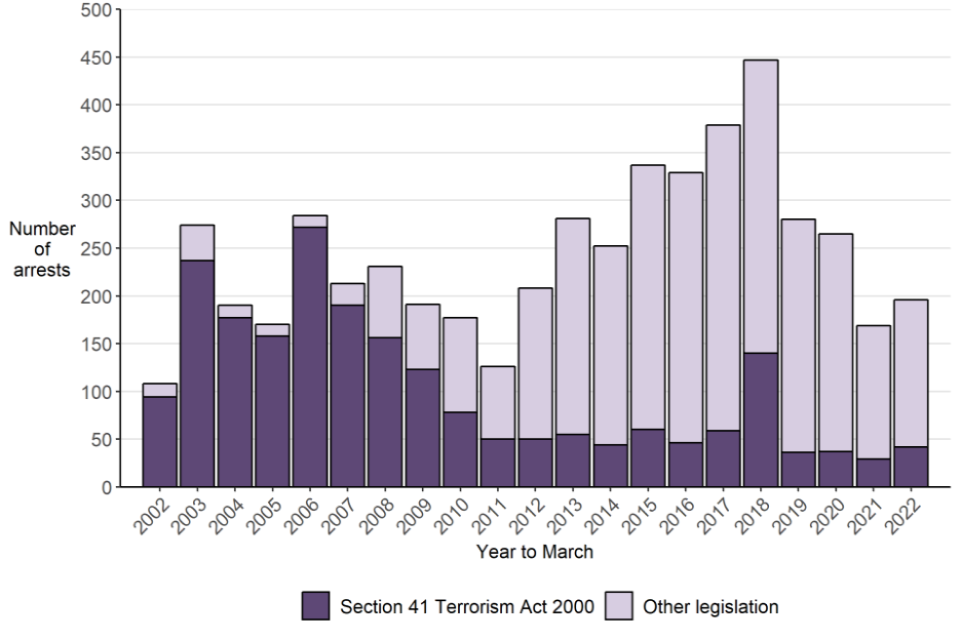
At the time of data provision, of the 196 arrests for terrorist-related activity:
- 59 (30%) resulted in a charge, of which 55 were for terrorism-related offences
- 83 (42%) persons were released under investigation
- 44 (22%) people were released without charge
- 10 (5%) faced alternative action, for example receiving a caution or recalled to prison
1. Introduction
1.1 Time period covered and data sources
This release covers the use of police powers under terrorism and subsequent legislation in Great Britain on a quarterly basis up to the year ending 31 March 2022. It also covers arrests for terrorist-related activity under other legislation such as the Police and Criminal Evidence Act (PACE).
The statistics in this release draw on a range of data sources. The Arrests and outcomes section contains data provided by the Counter Terrorism Policing Headquarters (CTPHQ) Coordination Centre and includes statistics for Great Britain on the:
- number of arrests for terrorist-related activity and outcomes (such as charges and convictions) following such arrest
- number of charges and convictions broken down by legislation used
- gender, age, ethnicity, and nationality of those arrested, charged and convicted
The Court proceedings section uses data from the Crown Prosecution Service Counter Terrorism Division (CPS CTD) and includes statistics for England and Wales on the:
- number of persons proceeded against by CPS CTD for terrorism-related offences
- number of persons that have been prosecuted and convicted broken down by the legislation used
- sentence length of those convicted for terrorism-related offences
- outcomes of appeals against such convictions or sentences.
The Terrorist prisoners section uses data from HM Prison and Probation Service (HMPPS) and the Scottish Prison Service (SPS) and includes statistics for Great Britain on the:
- number and ideology of persons in custody for Terrorism Act 2000 (TACT)-connected offences
- ethnicity, nationality and religion of those in custody
- number of persons released from custody by sentence length
The Other police powers under TACT 2000 section uses data provided by the Metropolitan Police Service (MPS) and CTPHQ, and includes statistics on the:
- number of stops and searches carried out by MPS under s.43 of TACT 2000
- number of stops and searches carried out by police under s.47a of TACT 2000
- number of examinations and subsequent detentions made in Great Britain under Schedule 7 to TACT 2000
- data on goods examinations, strip searches and on refusals of requests to postpone questioning (usually to enable an individual to consult a solicitor) under Schedule 7 to TACT 2000
- the number of cordons under s.33 of TACT 2000
From the year ending June 2019 publication onwards, data have also been collected and published on the total number of examinations and detentions made in the United Kingdom as a whole under Schedule 7 to TACT 2000, as well as how many examinations related to intra-UK journeys. An intra-UK examination is when a person has been examined under Schedule 7 TACT at a UK port either before or after a journey between one UK port and another UK port. This includes journeys between or within England, Wales, Northern Ireland and Scotland.
Furthermore, data have also been provided on how frequently other powers have been used in Great Britain under Schedule 7, to restrict or qualify a person’s access to a solicitor. Including: required to consult a solicitor by phone, delayed access to a solicitor, and required to consult in sight and hearing of a qualified officer.
Moreover, from the year ending June 2021 publication onwards, data has also been collected and published on the number of persons where one or more biometric identifier was taken during an examination made under Schedule 7 of the Terrorism Act 2000 in the United Kingdom. For the purposes of this statistical publication, a biometric identifier (taken during an examination under Schedule 7) includes photographs, fingerprints and DNA samples.
From the year ending September 2021 publication onwards, data has been collected and published on the number of persons detained and applications for extension of detention in Great Britain under Schedule 8 of the Terrorism Act 2000. Data has also been collected and published on the number of requests for access to a solicitor by persons detained in Great Britain under Schedule 8 of the Terrorism Act 2000. The user guide provides further details on these new statistics.
It is important to note that these new statistics are classed as ‘experimental’. Experimental statistics are new official statistics undergoing evaluation. More information about experimental statistics can be found on the UK Statistics Authority website. Home Office statisticians aim to improve the quality of the data in future releases by working with CTPHQ to develop quality assurance procedures.
The user guide provides further details on this release, including the strengths and limitations of the datasets, and the quality assurance processes involved in the production of this release. It also includes a summary of the criminal justice process, a glossary of terms used, and detail about the legislation and categories referred to in this release.
A flow chart summarising the Arrests and outcomes section of this release can be found in Annex A.
1.2 Future releases
The information published in the quarterly ‘Operation of police powers under the Terrorism Act 2000’ statistics is kept under review, taking into account the needs of users, and burdens on suppliers and producers, in line with the Code of Practice for Statistics. If you have any comments, suggestions or enquiries, please contact the team via email using: HSAI_Statistics@homeoffice.gov.uk.
1.3 National Statistics status
This publication has been assessed by the United Kingdom Statistics Authority and its National Statistics designation was confirmed in May 2016. This means that these statistics meet the highest standards of trustworthiness, impartiality, quality and public value, and are fully compliant with the Code of Practice for Statistics. As part of the assessment process, the Home Office reviewed and improved the user guide that accompanies this release. This now contains more details about the strengths and limitations of the various datasets within the publication, as well as the steps taken to engage with users. Further details on the assessment process can be found on the UK Statistics Authority website.
2. Arrests and outcomes
Key results
- in the year ending 31 March 2022, there were 196 arrests for terrorist-related activity in Great Britain, 27 more than in the previous 12-month period (an increase of 16%)
- at the time of data provision[footnote 1], 59 arrests resulted in a charge (30%), of which 55 were for terrorism-related offences
- in the year ending 31 March 2022, of the 42 individuals arrested under s41 of TACT 2000 in Great Britain who were subsequently detained, there were 35 applications for extension of detention granted by a judicial authority under Schedule 8 of TACT 2000 (multiple applications may be made for one individual)
- in the year ending 31 March 2022, of the 42 individuals arrested under s41 of TACT 2000 in Great Britain who were subsequently detained, there were 42 requests for access to a solicitor, 41 of which were allowed immediately
This section presents statistics on the number of persons arrested by the police in Great Britain where there was suspicion of involvement in terrorist-related activity, either at the time of arrest or at a subsequent point in the investigation. In some cases, evidence may emerge after an arrest for a terrorism-related offence that suggests a suspect does not have links to terrorist activity but has committed a non-terrorism-related offence. These cases are included in the data as non-terrorism-related charges and or convictions.
Prior to the June 2018 publication (covering the period to 31 March 2018), data in this release was restricted to arrests where the offence was considered to be related to terrorism. In response to feedback from stakeholders, Home Office statisticians widened the scope of the data collection to include all arrests with a terrorist element whether the offence was terrorism-related or not. This better reflects policing activity in recent years. Data in this release now contain information on all arrests related to terrorism activity, including a full back series.
Since the December 2019 publication (covering the period to 30 September 2019), postal charge requisitions and summonses have been included as part of the figures on arrests. This decision was taken following engagement with CTPHQ, as the postal charge requisitions and summonses can lead to terrorism-related charges and convictions. See the user guide for more detail.
Outcomes following arrests for terrorist-related activity are also included in the statistics, which show the number of arrests that led to a charge or prosecution as well as other outcomes. Demographic information about those arrested, charged and convicted is also provided in this section. All data in this section are based on the date of arrest. This allows users to see the outcomes of all the arrests in a specific period (such as how many led to a charge and conviction).
As cases progress over time, figures published in this release are likely to be revised. This is particularly relevant for more recent time periods where a larger number of cases will have not been finalised (‘released on bail’ or ‘awaiting prosecution’). The effect on the arrests total will be minimal but the number of charges and convictions currently reported will increase in future releases, especially for cases from the more recent quarters where a greater number have not yet reached the point of charge or conviction.
Data are provided to the Home Office by the CTPHQ Coordination Centre and are taken from a live database. This section includes annual breakdowns of the data from the 11 September 2001 (when the data collection began) to year ending March 2022, as well as quarterly trends over the most recent 9 quarters. The data were based on the latest position of each case as at the time of provision to the Home Office (on 22 April 2022).
A flow chart summarising this section is included in Annex A. This follows individuals from the point of arrest through to charge (or other outcome) and prosecution. Data tables A - A.01 to A - A.12c include data on arrests and outcomes. Annual tables, which breakdown the data by rolling years to March, are also provided alongside this release.
2.1 Arrests
In the year ending 31 March 2022, there were 196 arrests for terrorist-related activity in Great Britain, 27 more than the previous 12-month period (an increase of 16%) (Figure 2.1).
Figure 2.1: Arrests for terrorist-related activity, by legislation, years ending 31 March 2002 to 31 March 2022, Great Britain1,2,3
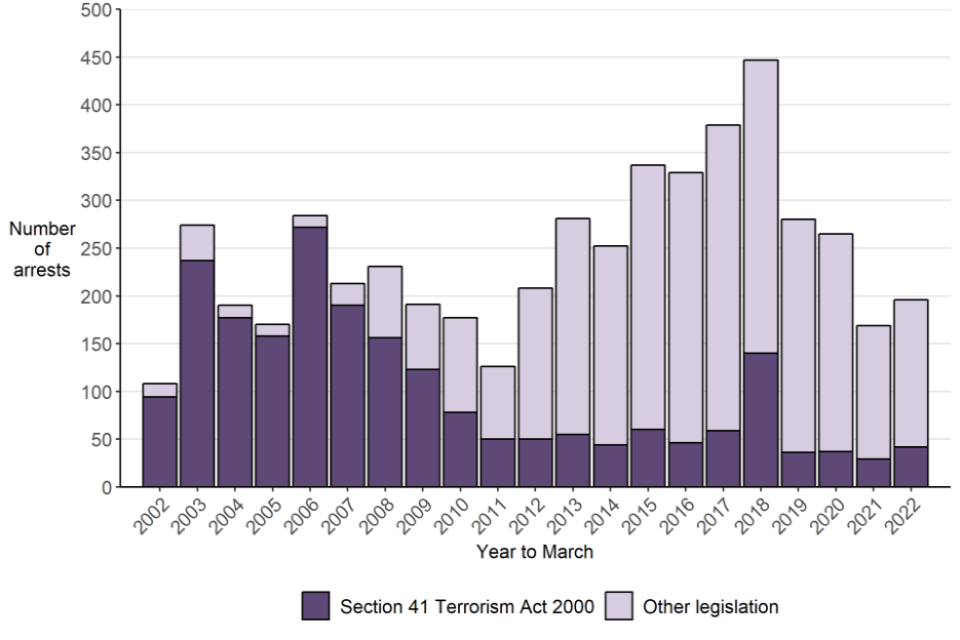
Source: CTPHQ Coordination Centre (see data table A - A.01)
Notes:
- Figures for the year ending 31 March 2002 include data from 11 September 2001 onwards.
- ‘Other legislation’ includes arrests under non-terrorism legislation, such as the Police and Criminal Evidence Act 1984.
- Includes arrests that are considered by the CTPHQ Coordination Centre to be terrorism-related, either at the time of arrest or at a subsequent point in the investigation.
There were reductions in the number of arrests starting from April to June 2020. The reductions were most evident in arrests under non-terrorism legislation and may reflect the general reduction in traditional crime during this period when there were public health restrictions in place to control the spread of the COVID-19 virus. This effect was most marked in April to June 2020 during the national lockdowns in England and Wales with just 31 arrests in this quarter. Following the easing of restrictions over the summer months, the number of arrests increased (for example, up to 55 arrests between October to December 2020). During the third national lockdown the number of arrests fell again, between January to March 2021, down to 39. In the latest two quarters, between October and December 2021, and January and March 2022, the number of arrests increased, to 51 and 50, respectively.
Figure 2.2: Arrests for terrorist-related activity, by legislation, 9 quarters to 31 March 2022, Great Britain1,2
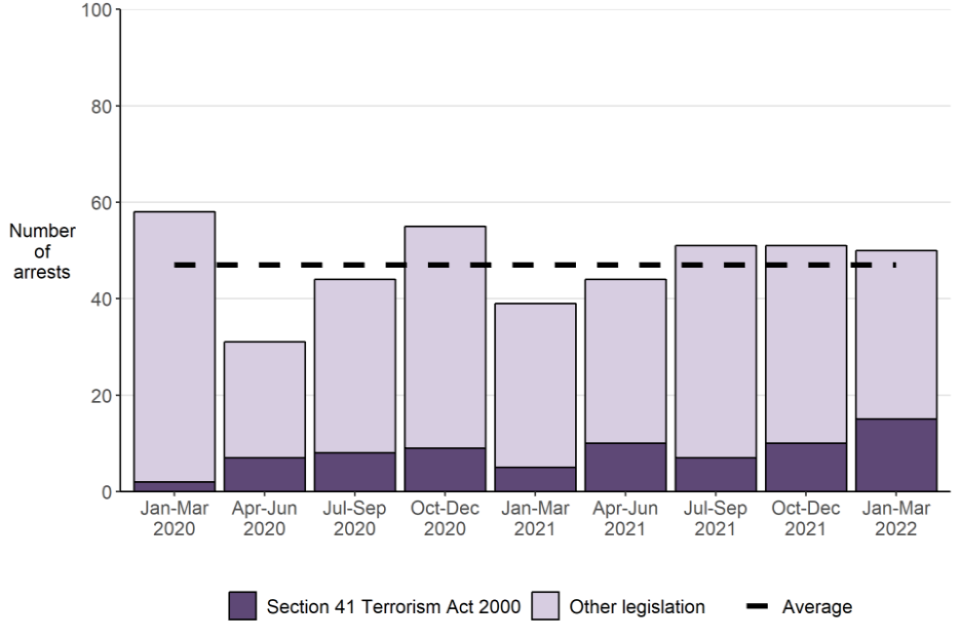
Source: CTPHQ Coordination Centre (see data table Q - A.01)
Notes:
- ‘Other legislation’ includes arrests under non-terrorism legislation, such as the Police and Criminal Evidence Act 1984.
- Includes arrests that are considered by the NCTPOC to be terrorism-related, either at the time of arrest or at a subsequent point in the investigation.
2.2 Pre-charge detention under Section 41 of the Terrorism Act 2000
Once a suspect has been arrested by the police, they may be held for a specified period of time before being charged, giving the police time to investigate and gather evidence related to potential terrorism offences. The current maximum period of detention under s.41 of TACT 2000 is 14 days (which reduced from the previous limit of 28 days on 25 January 2011). This compares with a maximum of four days under standard arrest powers. Further details of the legislation can be found in the user guide.
There were 42 detentions under s.41 of TACT 2000 in the year ending 31 March 2022, up from 29 detentions in the previous year. Of the 42 detentions in the latest year, 23 led to a charge (55%).
Further details on the length and outcomes of detentions under s.41 of TACT 2000 can be found in data table A - A.02.
2.3 Other powers under Schedule 8 to TACT 2000
Under Section 41 of TACT 2000, police officers have the power to arrest persons suspected of terrorism-related offences without a warrant. These arrest powers also allow the extended detention of persons beyond the maximum 4 days available under standard arrest powers, to a maximum of 14 days. In the year ending 31 March 2022, of the 42 individuals arrested under s41 of TACT 2000 in Great Britain who were subsequently detained, there were 35[footnote 2] applications for extension of detention granted by a judicial authority under Schedule 8 of TACT 2000.
Under Section 41 of TACT 2000, a person detained in police custody under the terrorism provisions is entitled to consult a solicitor privately. A police officer of at least the rank of superintendent can authorise a delay in permitting a detained person to consult a solicitor if they believe that exercising this right will result in any of the consequences listed in Schedule 8 of the act. Please see the user guide for further information. In the year ending 31 March 2022, of the 42 individuals arrested under s41 of TACT 2000 in Great Britain who were subsequently detained, there were 42 requests for access to a solicitor, 41 of which were allowed immediately.
2.4 Charges
In line with the general convention for Home Office criminal justice statistics, when a person is charged or prosecuted for multiple offences at the same time, only the most serious offence is counted – usually the one that carries the highest penalty. This “principal offence rule” means the statistics provide a count of individuals charged rather than the total number of charges. More detailed information on the principal offence rule can be found in the accompanying user guide. Further details of the legislation under which persons have been charged following an arrest for a terrorism-related activity can be found in data tables A - A.05a-c.
At the time of data provision[footnote 3], of the 196 arrests for terrorist-related activity in the year ending 31 March 2022:
- 59 (30%) resulted in a charge, of which 55 were for terrorism-related offences
- 83 (42%) persons were released pending further investigation
- 44 (22%) people were released without charge
- 10 (5%) faced alternative action, for example receiving a caution or recalled to prison
Given the number of cases still to be finalised in the latest year, the current charge rate shown in the more recent years/quarters is likely to be lower than final figures which will be published in subsequent releases. Until all cases in a given period are finalised, care should be taken when comparing charge rates over time.
Figure 2.3: Charging outcomes following an arrest for terrorist-related activity, 9 quarters to 31 March 2022, Great Britain1,2
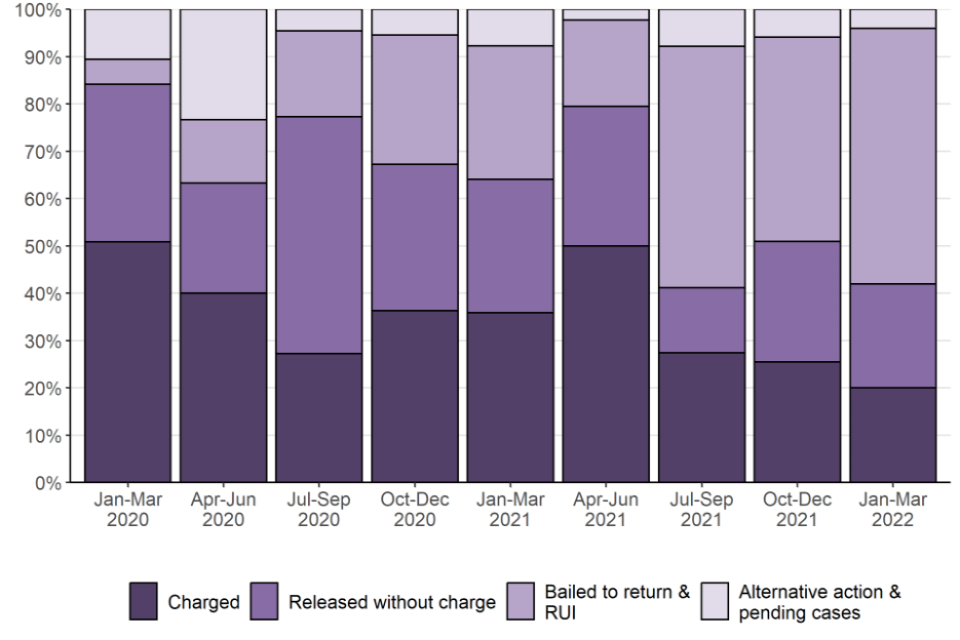
Source: CTPHQ Coordination (see data table A.03)
Notes:
- ‘Alternative action’ includes cautions for non-TACT 2000 offences, detentions under the Mental Health Act, recall to prison etc.
- ‘Bailed to return’ includes those released on bail pending further investigation, and those who have absconded from bail. Those who were released under investigation were previously unable to be recorded separately and were recorded as ‘released without charge’.
Figure 2.4: Charging outcomes following an arrest for terrorist-related activity, year ending March 2002 to March 2022, Great Britain1,2
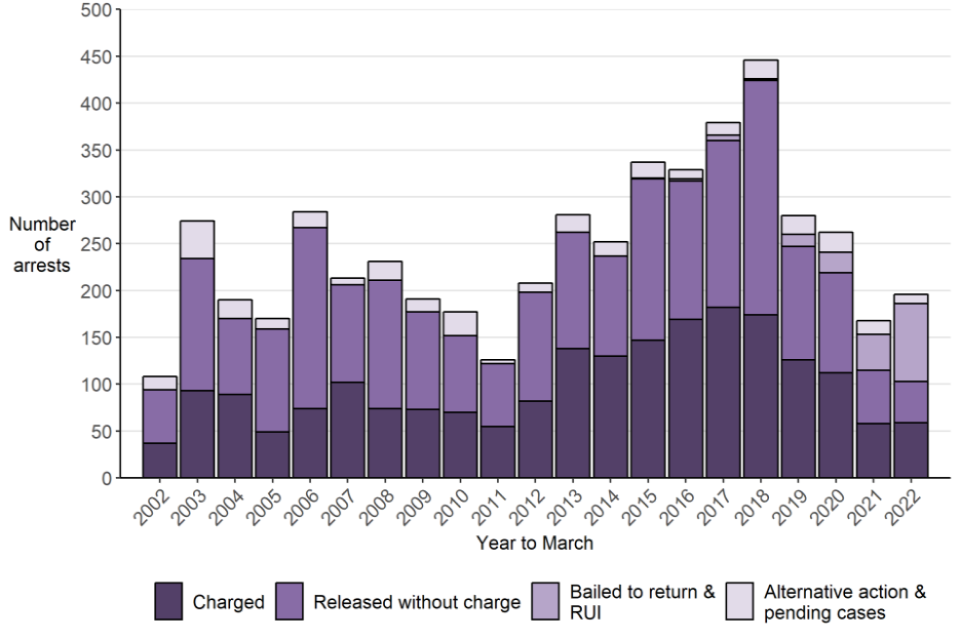
Source: CTPHQ Coordination Centre (see data table A - A.03)
Notes:
- ‘Alternative action’ includes cautions for non-TACT offences, detentions under the Mental Health Act, recall to prison, and transfers to immigration authorities.
- ‘Bailed to return’ includes those released on bail pending further investigations, and those who have absconded from bail. Those who were released under investigation were previously unable to be recorded separately and were recorded as ‘released without charge’.
2.4 Prosecutions
As with charges, statistics on prosecutions are also based on the principal offence rule (see section 2.3). Where an individual is prosecuted for more than one offence at a time, they are classified in terms of a single offence – usually the most serious.
Figure 2.5 shows the outcomes following a charge for a terrorism-related offence.
Further details of the specific legislation under which persons have been convicted following a charge for a terrorism-related offence can be found in data tables A - A.08a-c.
Figure 2.5: Outcomes following a charge for a terrorism-related offence, year ending 31 March 20221,2,3,4, Great Britain

Source: CTPHQ Coordination Centre (see data table A - A.06c)
Notes:
- Based on the time of arrest.
- A more detailed flow chart can be found in Annex A.
- Data presented are based on the latest position with each case as at the date of data provision from CTPHQ Coordination Centre (22 April 2022).
- The chart does not include outcomes following non-terrorism-related charges.
- Terrorism-related charges and convictions include some charges and convictions under non-terrorism legislation, where the offence is considered to be terrorism-related.
- Cases that are ‘awaiting prosecution’ are not yet complete. As time passes, these cases will eventually lead to a prosecution, ‘other’ outcome, or it may be decided that the individual will not be proceeded against.
- Excludes convictions that were later quashed on appeal.
- Includes other cases/outcomes such as cautions, transfers to UK Border Agencies, the offender being circulated as wanted and extraditions.
2.5 Demographics of persons arrested
This section provides more detail on the demographic and other characteristics of persons arrested. It includes data on:
- sex
- age
- ethnic appearance
- nationality
Sex
As in previous years, and similar to other types of crime, the vast majority of those arrested for terrorism-related activity were males (94%). However, twelve of the 196 arrests where sex was known were females (6%). This was a fall of four arrests and four percentage points compared with previous 12-month period. The decrease in proportion of female arrests was driven by the increase in the number of males arrested in the latest year, which increased by 32.
Age
As in previous years, the ‘30 and over’ age-group accounted for most arrests (46%). There was an increase in the number of arrests across all age-groups. The largest increase was in the Under 18 age group which increased from 21 to 29, while the 18-20 and ‘30 and over’ age groups both increased by 7.
Among those who were arrested, 15% were aged under 18 (up from 12% in the previous year). While this was the highest proportion seen in an annual period, it was largely a result of falls in arrests of those in older age-groups.
Ethnic appearance as recorded by the arresting officer
Figures in this section are based on the ethnic appearance of the arrestee as recorded by the arresting officer.
Arrests for those of White ethnic appearance increased by three, up from 88 to 91 arrests. There was also an increase in arrests for individuals in the ‘Other’ category, up from 18 to 45. There was a decrease in the number of arrests of people of Black ethnic appearance, from 12 arrests to 10, and a decrease in the number of arrests of people of Asian ethnic appearance (from 51 arrests to 50).
The proportion of White people arrested exceeded the proportion of Asian people arrested for the fourth consecutive year. Arrests of persons of White ethnic appearance accounted for 46% of arrests, down six percentage points on the previous year. Those of Asian ethnic appearance accounted for 26% of terrorist-related arrests, down 4 percentage points. The proportion of those arrested who were of Black ethnic appearance was 5%, down two percentage points compared with the previous year. Those of ‘Other’ ethnic appearance accounted for 23% of arrests, up 12 percentage points on the previous year[footnote 4].
Figure 2.6: Proportion of persons arrested for terrorist-related activity by ethnic appearance1,2, year ending 31 March 2021 and 31 March 2022, compared with total proportions since 11 September 2001
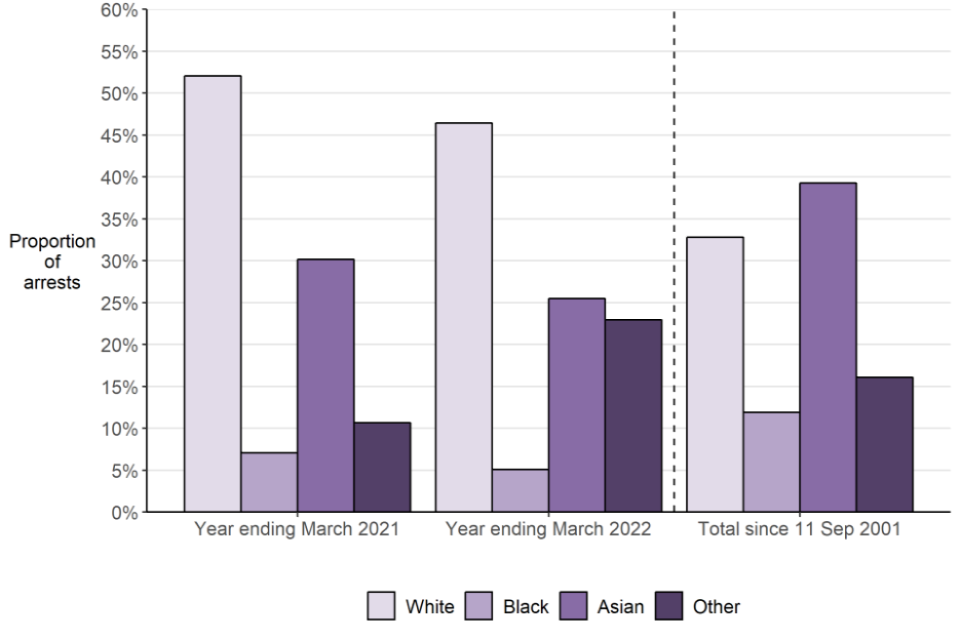
Source: CTPHQ Coordination Centre (see data table A - A.11)
Notes:
- As recorded by the police at time of arrest.
- Excludes those whose ethnicity is not known.
Nationality
Of those arrested in the latest year, 78% considered themselves to be of British or British dual nationality, which is unchanged from the previous year. The proportion increased from 29% in the year ending March 2002 to 77% in the year ending March 2015 and has not fallen below 67% since. Overall, since 11 September 2001 (when the data collection began), 61% of those arrested considered themselves to be of British or British dual nationality (Table 2.1).
Table 2.1: Number of persons arrested for terrorist-related activity, since 11 September 2001, by self-defined nationality1,2
Numbers & percentages, Great Britain
| Self-defined nationality | Total since Sep 11 2001 | Proportion of all arrests (%) |
|---|---|---|
| Great Britain3 | 3,139 | 61 |
| Algeria | 194 | 4 |
| Iraq | 180 | 4 |
| Pakistan | 171 | 3 |
| Iran | 99 | 2 |
| Afghanistan | 94 | 2 |
| Turkey | 86 | 2 |
| Somalia | 84 | 2 |
| India | 63 | 1 |
| Sri Lanka | 59 | 1 |
Source: CTPHQ Coordination Centre (see data table A.12a)
Notes:
- The nationalities presented here are those declared by persons at the time of arrest and may differ from their country of origin.
- Only the first 10 countries, by number of persons arrested for terrorist-related activity, are included in the table.
- Figures for Great Britain include those with ‘British dual’ nationality.
3. Court proceedings
Key results
- in the year ending 31 March 2022, 60 persons were tried for terrorism-related offences, six more than in the previous year
- of the 60 persons tried for terrorism-related offences, 54 were convicted (90%)
- of the 54 persons convicted of terrorism-related offences, 37 (69%) pleaded guilty and 17 (31%) entered a not-guilty plea
- there were 20 appeals against court convictions or sentences, none of which resulted in a conviction being quashed
This section presents statistics on prosecutions for terrorism-related offences in England and Wales. It provides data on the number of persons prosecuted and convicted, including information on the legislation under which they were prosecuted. It also provides information on the length and type of sentence that each convicted person received. Data in this section are based on the trial completion date and are not directly comparable to the prosecutions data in section 2, Arrests and outcomes, which is based on the date of arrest.
Data are provided to the Home Office by the Crown Prosecution Service Counter Terrorism Division (CPS CTD). The data cover terrorism-related court cases that were completed in the 12 years from the year ending March 2010 up to the year ending March 2022.
3.1 Court proceedings
In the year ending 31 March 2022, 60 persons were tried for terrorism-related offences, six more than in the previous year, but a fall of 21 (26%) from the peak of 81 trials in the year ending March 2018 (data table A C.01). This peak in court proceedings in the year ending March 2018 followed on from the highest volume of terrorism-related arrests in that year.
During 2020 and 2021, there was an increase in the overall backlog of court cases, due to COVID-19[footnote 5] . However, the number of persons proceeded against by the Crown Prosecution Service for terrorism-related offences remained fairly consistent during this period, reflecting that these more serious offences have been prioritised.
Of the 60 persons tried for terrorism-related offences, 54 were convicted. Figure 3.1 shows the outcomes for the 60 persons proceeded against.
Figure 3.1: Outcome of terrorism-related trials under TACT and non-TACT legislation, year ending 31 March 2022, England and Wales1,2,3,4
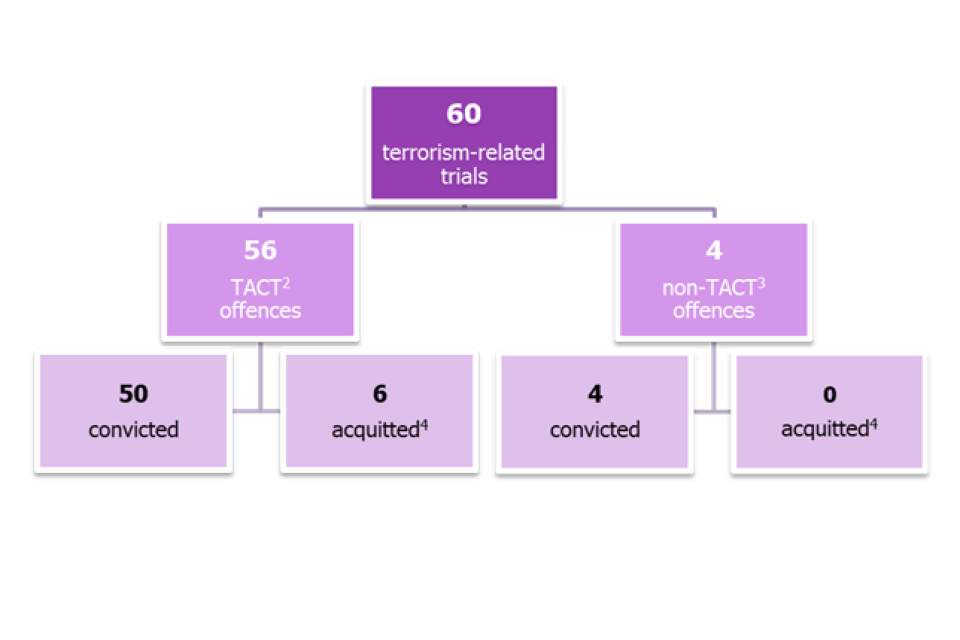
Source: CPS CTD (see data tables A C.01 - A C.03)
Notes:
- Based on the principal offence for which the defendant was prosecuted against.
- TACT offences include offences specifically under terrorism legislation.
- Non-TACT offences include offences under other legislation.
- Can include trials ending in a hung jury, or where the prosecution offered no evidence.
3.2 Sentencing
The most common sentence length in the latest year was of less than four years, which accounted for 35% of sentences (19 of 54 convictions). Of these, 13 sentences were between one and four years (24% of total), and 6 were less than a year (11% of total). There were also 17 sentence lengths between four and ten years, accounting for 31% of sentences.
Those given a life sentence accounted for 4% of all those sentenced in the latest year (two sentences). There were 2 sentences of ten years or more, an increase from zero in the pervious year. The number of non-custodial sentences increased from 7 to 13 in the latest year, the highest in an annual period since data collection began, making up 24% of sentences handed down, up 10 percentage points on the previous year.
Of the 50 persons convicted of terrorism-related offences, 37 (69%) pleaded guilty and 17 (31%) entered a not-guilty plea. This was a higher proportion compared with the previous year, when 31 of the 49 persons convicted (63%) entered a guilty plea.
Figure 3.2: Sentence length for persons convicted for terrorism-related offences, year ending 31 March 2022 compared with the previous year, England and Wales1,2
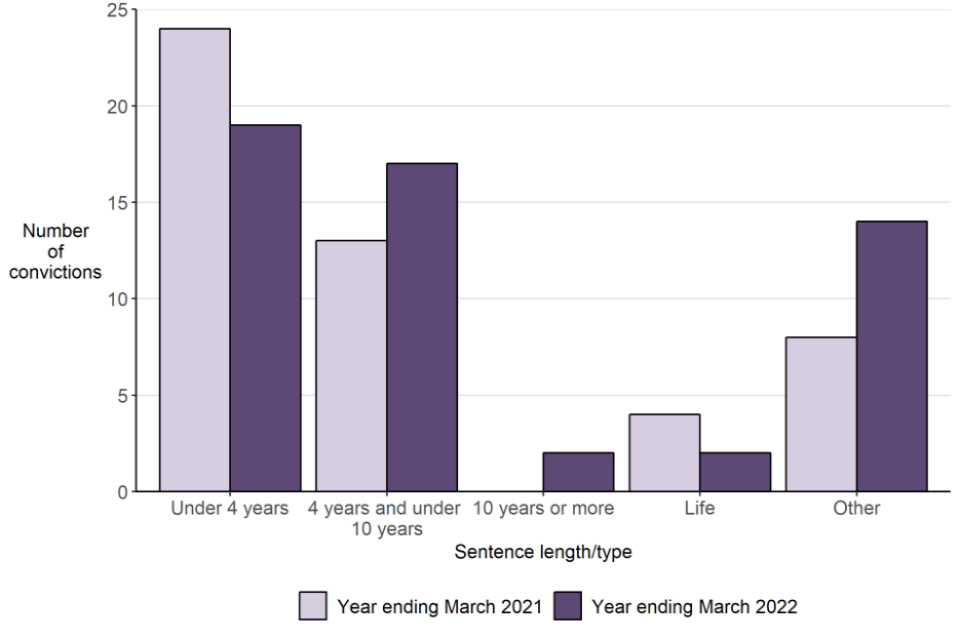
Source: CPS CTD (see data table A C.04)
Notes:
- Based on the trial completion date.
- The ‘Other’ category includes hospital orders and non-custodial sentence.
3.3 Appeals against convictions and sentences
Over the 13-year period from 1 April 2009 to 31 March 2022, a total of 172 appeals against terrorism convictions were heard, of which 153 were either dismissed by the court or abandoned by those lodging the appeal prior to the decision being made (see data table A C.05). Over the 13-year time period, one of the appeals resulted in convictions being quashed. Also over the 13-year time period, 17 appeals resulted in a sentence being reduced and one resulted in a sentence being increased.
In the latest year there were 20 appeals, an increase of four compared with 16 in the previous year. All the appeals were either dismissed or abandoned.
4. Terrorist prisoners
Key results
- as at 31 March 2022, there were 233 persons in custody for terrorism-connected offences in Great Britain
- of those in custody, the vast majority (68%) were categorised as holding Islamist-extremist views; a further 24% were categorised as holding Extreme Right-Wing ideologies and 6% were categorised as holding Other ideologies
- a total of 44 prisoners held for terrorism-related or terrorism-connected offences were released from custody in Great Britain in the latest year for which figures are available (year ending 31 December 2021)
Statistics presented in this section give information on the number of persons in custody for terrorism-connected offences in Great Britain. This includes both those that had been convicted and those being held on remand (that is, held in custody until a later date when a trial or sentencing hearing will take place). This section includes breakdowns of their ethnicity, nationality, ideology and religion.
Prior to June 2018, the Home Office published figures on both terrorist prisoners and domestic extremist/separatist prisoners. However, following feedback from data providers at HM Prison and Probation Service (HMPPS), it was decided that prisoners categorised as ‘domestic extremist/separatist’ prisoners would be counted within the ‘TACT/TACT-related’ cohort, where the threshold for this is met, i.e. for offences which the court has determined have a terrorist connection. This was to remove the previous subjectivity around the categorisation of domestic extremist prisoners.
From September 2020 onwards, the Ministry of Justice and Home Office have formally adopted the definition ‘Terrorism-Connected Offender’. This definition replaced the previously used definition ‘Terrorism-Related Offender’ which will no longer be used for the purposes of publishing official statistics for terrorist prisoners. The change in definition between the publication of statistics as at 30 June 2020 and 30 September 2020 caused roughly 10% of prisoners to be removed from the classification at that point. For this reason, figures for September 2020 onwards are not directly comparable with previous years or quarters.
This definition change is in alignment with Part 2 of Schedule 19ZA of the Criminal Justice Act 2003 (as inserted by the Terrorist Offenders (Restriction of Early Release) Act 2020), which concerns those offenders who have not committed terrorist offences (that is, those listed in Part 1 of the Schedule) but who have committed other specified offences which the court has determined have a ‘terrorist connection’. That determination may only be made by the sentencing court in accordance with Part 3 of the Counter-Terrorism Act 2008 and only after consideration of the requirements/matters specified in that Act.
Data were provided to the Home Office by HMPPS and the Scottish Prison Service (SPS), giving information about the prison population for the 11 years from 31 March 2013 to 31 March 2022, and also at the end of the nine quarters to 31 March 2022. Data on the number of prisoners released cover the nine quarters to 31 December 2021. Prisoner release figures up to 31 March 2022 are not yet available as these will form a subset of the prison releases statistics which will be published by the Ministry of Justice in their Offender management statistics quarterly release in July 2022.
4.1 Persons in Custody
As at 31 March 2022, there were 233 persons in custody for terrorism-connected offences in Great Britain.
Of those in custody, 159 (68%) were categorised as holding Islamist-extremist views, two more compared to the previous year. A further 57 (24%) were categorised as holding Extreme Right-Wing ideologies, up by 30% and a three percentage point increase compared to the previous year. The remaining 17 prisoners (7%) were categorised as holding beliefs related to other ideologies, the same as the previous year.
Figure 4.1: Number of persons in custody for terrorism-related offences, by ideology, year ending March 2013 to year ending March 2022, Great Britain1,2

Source: CPS CTD (see data tables A P.01)
Notes:
- The ‘Other’ category includes any prisoners not classified as holding a specific ideology.
- Following changes agreed with the prison service, for figures at 30 September 2020 onwards, we have adopted the definition ‘Terrorism-connected offender’ to replace the previously used definition ‘Terrorism-related offender’ for this time-series.
4.2 Persons released from custody
A total of 44 terrorist prisoners were released from custody in Great Britain in the latest year for which figures were available (year ending 31 December 2021)[footnote 6]. This figure includes 29 terrorism-connected offenders released between January and June 2021 and 15 terrorism-connected offenders between July 2021 and December 2021.
Of these, 31 (70%) were persons released from custody after serving sentences, many of whom will be subject to meeting certain licence conditions.
Of the 44 released from custody, 11 had received sentences of less than four years, and 20 had sentences of four years or more (including one life sentence). No one was released following an indeterminate sentence for public protection. 13 people had been convicted but not yet been sentenced.
5. Other police powers under the Terrorism Act 2000
Key results
- in the year ending 31 March 2022, 366 persons were stopped and searched by the Metropolitan Police Service under s.43 of TACT 2000; this was a decrease of 29% compared with the previous year’s total of 513
- in the latest year, there were 31 arrests resulting from a s.43 stop and search, 24 less than the previous year (55)
- in the latest year, 2,604 persons were subject to the use of Schedule 7 to TACT 2000 in Great Britain; this was an increase of 15% compared with the previous year (where there were 2,263 examinations)
- in the year ending 31 March 2022, 41% of examinations made under Schedule 7 of TACT 2000 resulted in at least one biometric identifier being taken from an individual (1,148 persons out of 2,768 examinations)
This section presents statistics on the use of stop and search powers available to the police under the Terrorism Act 2000 (TACT 2000). It includes data on the number of stop and searches, and resultant arrests, carried out under s.43 of TACT 2000 (by the Metropolitan Police Service (MPS) only) and s.47A of TACT 2000 (by all police forces). It also contains data on the use of powers under Schedule 7 to TACT 2000 in Great Britain. This includes the number of examinations, resultant detentions, strip-searches, the number of times postponement of questioning (usually to enable an individual to consult a solicitor) was refused, and the number of sea and air freight examinations. It also contains data on the number of persons where one or more biometric identifier was taken during an examination or a detention made under Schedule 7 of TACT 2000. For the purposes of this statistical publication, a biometric identifier (taken during an examination under Schedule 7) includes photographs, fingerprints and DNA samples.
Data on s.47a stop and search are provided to the Home Office by police forces, and data on s.43 stop and search are currently provided on a quarterly basis for this release by MPS only. Following a change made to the Police Powers and Procedures statistical collection, this data is now available for all police force areas and will be published annually here on GOV.UK.. Data on Schedule 7 are provided to the Home Office by the Counter Terrorism Policing Headquarters (CTPHQ). This section includes annual breakdowns for the last 12 years up to the year ending March 2022.
Following the Parsons Green attack, on 15 September 2017, the police used the power of stop and search under s.47a of TACT 2000 (previously s.44) for the first time. This power allows the police to exercise stop and searches when there is reasonable suspicion an act of terrorism will take place, and only when such powers are considered necessary to prevent such an act taking place. This was the first time they had been used in Great Britain since the legislation was formally amended in 2011. Following the attack on Parsons Green, four forces authorised the use of these powers: British Transport Police, City of London Police, North Yorkshire Police and West Yorkshire Police. There was a total of 128 stops (126 of which were conducted by BTP) resulting in four arrests (all BTP). There have since been no stop and searches under s.47a of TACT 2000.
Further details on the use of s.47a can be found in the code of practice for the exercise of stop and search powers.
5.1 Stop and search under Section 43 of the Terrorism Act 2000
Section 43 of TACT 2000 allows a constable to stop and search a person whom he/she reasonably suspects to be involved in terrorist activity. This section includes data from MPS only and excludes ‘vehicle only’ stops and searches.
There was a large reduction in the use of s.43 stops between 2011 (when the data collection began) and 2015, during which time numbers fell 64% (down from 1,151 to 410 stops). There was then a general increase in the next three years, up to a total of 808 stops in 2018. In the year ending 31 March 2022, 366 persons were stopped and searched by MPS under s.43 of TACT 2000, the lowest number since data collection began and a decrease of 29% when compared with the 513 in the year ending 31 March 2021.
From the June 2022 publication onwards, data on stops and searches of persons made by the Metropolitan Police under s43 of the Terrorism Act 2000 by self-defined ethnicity will be published using the ONS 16+1 self-defined ethnicity codes[footnote 7].
In the latest year, there were 31 arrests resulting from a s.43 stop and search, down 24 and a 44% decrease from the previous year’s total of 55. 8% of stops resulted in arrests, three percentage points lower compared to the previous year.
Ethnicity was only stated in 65% of stops in the latest year, two percentage points lower compared to the previous year, which was the lowest proportion since data collection began in 2011. The number of cases where ethnicity was known was at its highest at 92% in the year ending March 2012 and has steadily declined since. This information relies on the person stopped being willing to define their ethnicity and the officer recording it accurately.
In cases where the ethnicity[footnote 8] was known:
- 41% identified as ‘White’
- 32% identified as ‘Asian or Asian British’
- 12% identified as ‘Black or Black British’
- 11% identified as ‘Chinese or Other’
- 5% identified as ‘Mixed’
Figure 5.1: Stop and searches under s.43 of TACT 2000, MPS

Source: MPS (see data table A S.01)
Notes:
- Excludes ‘vehicle only’ searches.
Figure 5.2: Arrest rate following stop and searches under s.43 of TACT 2000, MPS
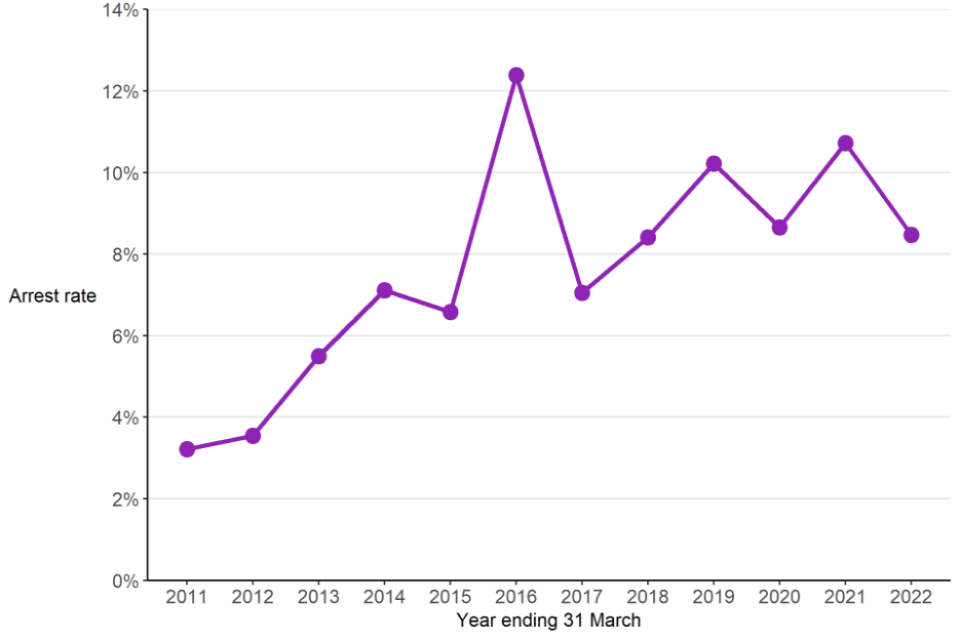
Source: MPS (see data table A S.01)
Notes:
- Excludes ‘vehicle only’ searches.
Details on the overall use of stop and search in England and Wales can be found in the Home Office Police powers and procedures, England and Wales statistical release. MPS also publishes monthly reports on the use of stop and search within its force area.
5.2 Schedule 7 to TACT 2000
Under Schedule 7 to TACT 2000, an examining officer has a number of powers, the uses of which are covered in this section. These include:
- examinations of persons and resultant detentions
- strip-searches
- refusals to postpone questioning (usually to enable an individual to consult a solicitor)
- examinations of goods
Data have also been provided on how frequently other powers have been used in Great Britain under Schedule 7 to restrict or qualify a person’s access to a solicitor. As well as ‘refusal to postpone questioning’, which has been published since 2016, this release now also covers use of powers where a person is:
- required to consult a solicitor by phone
- delayed access to a solicitor
- required to consult in sight and hearing of a qualified officer
Data on the number of examinations made under Schedule 7 of TACT 2000 in the United Kingdom and the number of intra-UK examinations has also been collected. An intra-UK examination is when a person has been examined at a UK port either before or after a journey between one UK port and another UK port. This includes journeys between or within England, Wales, Northern Ireland and Scotland.
Moreover, as of the June 2021 publication of this release, data on the number of persons where one or more biometric identifier was taken during an examination made under Schedule 7 of TACT 2000 in the United Kingdom has also been provided.
Examinations and resultant detentions
An examining officer may stop and question individuals entering and leaving the country through ports, airports, international rail stations and the border area. When necessary they may also detain and search individuals. The aim is to determine whether or not that person is or has been concerned with the commission, preparation or instigation of acts of terrorism.
In the year ending 31 March 2022, a total of 2,604 persons were subject to the use of this power in Great Britain. This was an increase of 15% compared with the previous year (where there were 2,263 examinations), and a 96% decrease since the data were first collected in the year ending 31 March 2012 (when 63,902 persons were examined under Schedule 7). Prior to the most recent year there had been average annual falls of 28%.
There was a large reduction in examinations under Schedule 7 of TACT 2000 between 2020 and 2021 due to the impact of the COVID-19 pandemic on international travel. Passenger numbers at air and sea ports in particular were at unprecedented low levels. This is still impacting numbers of examinations now. In the latest quarter (January to March 2022) there were 547 examinations, compared to 1,490 examinations in the same quarter in 2020; a 63% decrease . There has also been increased public scrutiny of this power in recent years, which may have driven a more targeted approach in its use. This is reflected in the increased rate of detention (see Figure 5.3).
From the June 2022 publication onwards, data on examinations and resultant detentions made under Schedule 7 of the Terrorism Act 2000 by self-defined ethnicity will be published using the ONS 16+1 self-defined ethnicity codes[footnote 9].
Ethnicity was stated in 78% of cases, the lowest proportion since data collection began in 2011. In cases where the ethnicity[footnote 10] was known:
- 34% identified as ‘Asian or Asian British’
- 32% identified as ‘Chinese or Other’
- 20% identified as ‘White’
- 9% identified as ’Black or Black British’
- 6% identified as ’Mixed’
Figure 5.3: Number of Schedule 7 to TACT 2000 examinations1 and resultant detentions, 9 quarters to 31 March 2022, Great Britain

Source: CTPHQ (see data table Q - S.04)
Notes:
- Excludes examinations of unaccompanied freight.
In the year ending 31 March 2022, 2,768 examinations were made under Schedule 7 of TACT 2000 in the United Kingdom, 19% higher than the previous year when 2,319 examinations were made. Of the 2,768 examinations made in the year ending 31 March 2022, 608 (22%) were Intra-UK examinations, compared to 526 of 3,319 (23%) in the previous year.
In the year ending 31 March 2022, 41% of examinations made under Schedule 7 of TACT 2000 resulted in at least one biometric identifier being taken from an individual (1,148 persons out of 2,768 examinations).
5.3 Other powers under Schedule 7 to TACT 2000
The following section includes information on several additional powers under Schedule 7 to TACT 2000. This includes:
- strip-searches
- postponement of questioning refusals
- examinations of goods (sea and air freight)
Data on these powers have been collected by the Home Office since April 2015.
In the year ending 31 March 2022:
- six strip-searches were carried out under the power
- a total of 540 air freight examinations (a fall of 25% compared with the previous year); the volume of air freight examinations still remains significantly below that of pre-Covid levels
- 382 sea freight examinations (a decrease of 80% compared with the previous year) were conducted in Great Britain
- there were no occasions where postponement of questioning (usually to enable an individual to consult a solicitor) was refused
Furthermore, data have been provided on how frequently powers have been used to restrict or qualify a person’s access to a solicitor by: requiring the person to consult a solicitor by phone, delaying access to a solicitor, and requiring the person to consult in sight and hearing of a qualified officer. These data have been collected since April 2019.
In the year ending 31 March 2022, there were four instances where an individual was delayed access to a solicitor.
Details on each power can be found in the user guide.
6. Further information
Accompanying user guide and tables
The user guide provides further details on this release, including the strengths and limitations of the datasets, and the quality assurance processes involved in the production of this release. It also includes a summary of the criminal justice process, a glossary of terms used, and detail about the legislation and categories mentioned in this release.
A flow chart summarising the Arrests and outcomes section of this release can be found in Annex A.
Future Releases
The information published in the quarterly ‘Operation of police powers under the Terrorism Act 2000’ statistics is kept under review, taking into account the needs of users, and burdens on suppliers and producers, in line with the Code of Practice for Statistics. If you have any comments, suggestions or enquiries, please contact the team via email using: HSAI_Statistics@homeoffice.gov.uk.
Other related publications
The annual ‘Police powers and procedures’ publication provides information on use of various powers by police in England and Wales including: arrests for notifiable offences, stop and searches under section 1 PACE and associated legislation, Best Use of Stop and Search (BUSS) statistics, motoring offences, and detentions under the Mental Health Act 1983.
The annual ‘Individuals referred to and supported through the Prevent programme’ publication contains Experimental Statistics on the number of individuals recorded as having been referred to and supported through the Prevent programme due to concerns they were vulnerable to a risk of radicalisation.
Northern Ireland Security Statistics are published by the Northern Ireland Office at Northern Ireland Terrorism Legislation - Annual Statistics 2020/21.
Feedback and enquiries
We welcome feedback on the quarterly statistics release. If you have any feedback or enquiries about this publication, please contact HSAI_Statistics@homeoffice.gov.uk.
-
Data on arrests are based on the latest position with each case as at the date of data provision from CTPHQ Coordination Centre (22 April 2022). ↩
-
Multiple applications may be made for one individual. ↩
-
Data on arrests are based on the latest position with each case as at the date of data provision from CTPHQ Coordination Centre (22 April 2022). ↩
-
As of July 2021, Police Force Areas (PFA’s) are collecting data on ethnicity using the 18+1 ethnicity codes. Not all PFA’s are using this collection method yet, so there is a mix of ethnicity data being collected and it is not consistent across all PFA’s as of yet. This means that more individuals than usual are being classified under the ‘Other’ ethnicity category. Over time, the remaining PFA’s will be using the 18+1 ethnicity codes consistently,and this change is expected to be fully implemented by the December 2022 publication. As a result, this publication still uses the ethnicity breakdowns using the current five as seen above. ↩
-
CPS response to COVID-19: dealing with backlogs – HM Crown Prosecution Service Inspectorate – March 2021. ↩
-
Figures as at 31 March 2022 are not yet available from HMPPS as these will be published by MoJ in July 2022. ↩
-
Self-defined ethnicity data in the stop and search and examination and resultant detentions sections are based upon the 16 distinct ethnic categories (plus a ‘Not stated’ category) used during the 2001 census, and are grouped into 5 main categories: Term: White Description: British, Irish, Other; Term: Mixed Description: White and Black Caribbean, White and Black African, White and Asian, Other Mixed; Term: Asian (or Asian British) Description: Indian, Pakistani, Bangladeshi, Other Asian; Term: Black (or Black British) Description: Caribbean, African, Other Black; Term: Chinese or Other Description: Chinese, Other. ↩
-
Self-defined ethnicity data in the stop and search and examination and resultant detentions sections are based upon the 16 distinct ethnic categories (plus a ‘Not stated’ category) used during the 2001 census, and are grouped into 5 main categories: Term: White Description: British, Irish, Other; Term: Mixed Description: White and Black Caribbean, White and Black African, White and Asian, Other Mixed; Term: Asian (or Asian British) Description: Indian, Pakistani, Bangladeshi, Other Asian; Term: Black (or Black British) Description: Caribbean, African, Other Black; Term: Chinese or Other Description: Chinese, Other. ↩
